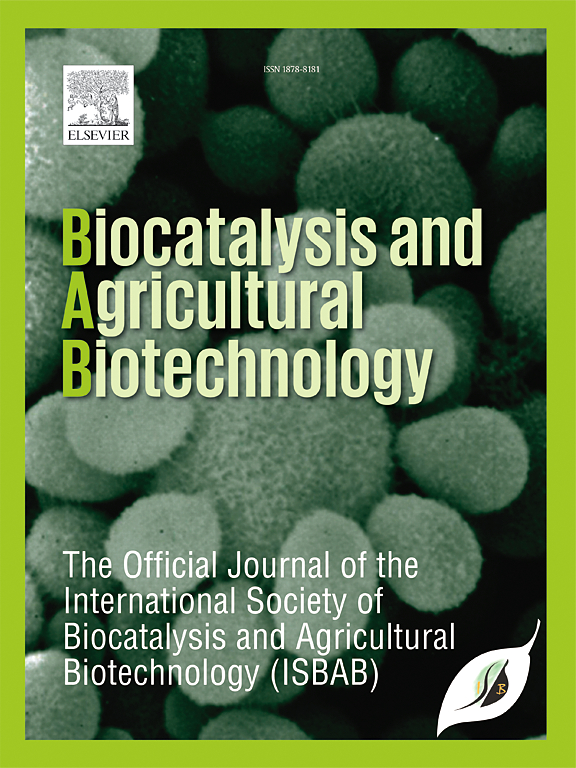以大豆糖蜜为基础的培养基优化细菌生物量生产,作为大豆作物接种剂开发的潜在成分
IF 3.8
Q2 BIOTECHNOLOGY & APPLIED MICROBIOLOGY
引用次数: 0
摘要
本研究旨在优化以大豆糖蜜为基础的摇瓶培养培养基的细菌生物量,作为大豆作物接种剂开发的潜在组成部分。6462年Bradyrhizobium yuanmingense SEMIA Bradyrhizobium pachyrhizi SEMIA 6464年,根瘤菌tropici SEMIA 4077和根瘤菌freirei SEMIA 4080进行评估。B. yuanmingense SEMIA 6462在培养72 h后的生物量产量最高,为5.48 g L−1。针对该微生物,提出了10变量Plackett-Burman (PB)设计和24中心复合旋转设计(CCRD)来优化生物质生产。影响最大的变量是大豆糖蜜、氯化钠、二水合氯化钙和酵母浸出液浓度,pH调节为7,同时从培养基中去除二碱式和一碱式磷酸钾、七水硫酸镁、七水氯化锰和吐温80。经实验验证的最佳工艺条件为:100 g L−1大豆糖蜜、0.8 g L−1酵母膏、0.45 g L−1氯化钠、0.3 g L−1二水氯化钙。在这些条件下,生物质产量达到38.6 g L−1,比初始值(5.48 g L−1)增加了604.93%,同时每千克生物质的培养基成本降低了70%。结果表明,栽培条件对提高根瘤菌生物量的有效性,突出了大豆糖蜜作为生产微生物接种剂的替代和可持续底物的潜力。本文章由计算机程序翻译,如有差异,请以英文原文为准。
Optimization of bacterial biomass production using soybean molasses-based medium as a potential component for bean crop inoculant development
This study aimed to optimize bacterial biomass production using a soybean molasses-based medium in shaken flask cultures as a potential component for bean crop inoculant development. Bradyrhizobium yuanmingense SEMIA 6462, Bradyrhizobium pachyrhizi SEMIA 6464, Rhizobium tropici SEMIA 4077, and Rhizobium freirei SEMIA 4080 were evaluated. B. yuanmingense SEMIA 6462 presented the highest biomass production, which was 5.48 g L−1 after 72 h of cultivation. For this microorganism, a Plackett-Burman (PB) design with ten variables followed by a 24 Central Composite Rotatable Design (CCRD) were proposed to optimize biomass production. The variables with the greatest influence were soybean molasses, sodium chloride, calcium chloride dihydrate, and yeast extract concentrations, with the pH adjusted to 7, while dibasic and monobasic potassium phosphates, magnesium sulfate heptahydrate, manganese chloride heptahydrate, and Tween 80 were removed from the medium. The best conditions established by an empirical model and validated by experimental assays were 100 g L−1 soybean molasses, 0.8 g L−1 yeast extract, 0.45 g L−1 sodium chloride, and 0.3 g L−1 dihydrate calcium chloride. Under these conditions, biomass production reached 38.6 g L−1, representing a 604.93 % increase from the initial value (5.48 g L−1) while also reducing the medium cost per kilogram of biomass by 70 %. The results demonstrate the efficacy of cultivation conditions in increasing rhizobia biomass production, highlighting the potential of soybean molasses as an alternative and sustainable substrate to produce microbial inoculants.
求助全文
通过发布文献求助,成功后即可免费获取论文全文。
去求助
来源期刊

Biocatalysis and agricultural biotechnology
Agricultural and Biological Sciences-Agronomy and Crop Science
CiteScore
7.70
自引率
2.50%
发文量
308
审稿时长
48 days
期刊介绍:
Biocatalysis and Agricultural Biotechnology is the official journal of the International Society of Biocatalysis and Agricultural Biotechnology (ISBAB). The journal publishes high quality articles especially in the science and technology of biocatalysis, bioprocesses, agricultural biotechnology, biomedical biotechnology, and, if appropriate, from other related areas of biotechnology. The journal will publish peer-reviewed basic and applied research papers, authoritative reviews, and feature articles. The scope of the journal encompasses the research, industrial, and commercial aspects of biotechnology, including the areas of: biocatalysis; bioprocesses; food and agriculture; genetic engineering; molecular biology; healthcare and pharmaceuticals; biofuels; genomics; nanotechnology; environment and biodiversity; and bioremediation.
 求助内容:
求助内容: 应助结果提醒方式:
应助结果提醒方式:


